has some very interesting material for any artist, collector or person that just enjoys oil paintings. They cover many different topics such as, artist interviews, how to paint like certain artists and tips for artists, just to name a few. Back in April,
interviewed Andy on his painting techniques and created a good read that I wanted to share. Below is the post from Pototschnik that I found on the site. If you enjoy it, be sure to check out the other posts from Oil Painters of America and even subscribe. Don’t forget to check out John Pototschnik’s
also, as he is a wonderfully talented artist himself. Enjoy!

Andy Thomas
I first met Andy Thomas more than 20 years ago while participating in the Midwest Gathering of the Artists Show in Carthage, MO. His talent was obvious, so to see his career explode as it has in recent years as a painter of western themes, well, it’s really not that surprising.
His paintings now garner well into the five figures.
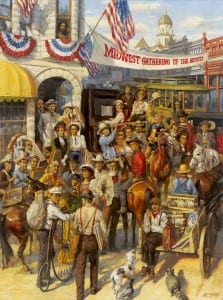
Spirit of the MGA – 40″x 30″ – Oil
Thomas captured, in his trademark style, many of the participants in the Midwest Gathering of the Artists Show with whom we became friends. I’m depicted with the highwheeler, indicating my love of cycling.
Mark Smith, co-founder of the Greenhouse Gallery of Fine Art in San Antonio, TX, and exclusive representative of Thomas’ work said, “Andy represents one of the most talented and creative painters working today. He has gained wide respect for his portrayal of the horse and its historic role in the old west and, as a result, has become one of the most sought out and collected painters of the historic time period known as the Old West. Collectors respectfully refer to Andy as a great “story teller” and compare his paintings favorably to the works of Remington and Russell. Through his paintings, Andy allows the viewer to be a participant in the scene rather than a spectator”.
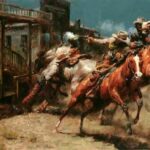
Bad Whiskey – 24″x 48″ – Oil
At the Coeur d’ Alene art auction in 2009, this painting set an auction record for Thomas’s work, selling for $110,000
Things could have turned out quite differently. I remember being notified in 1996 that Andy had been injured in an explosion while working in his shop. His hands had been severely damaged. I couldn’t believe it, and feared the worst. Later, in an attempt to return to painting prematurely, he further injured his right hand. That’s when he took up painting with his left hand, producing some amazing work. Now that both hands are fully healed, he is able to paint equally well with both hands simultaneously while working on two different paintings…doubling his production…just kidding.
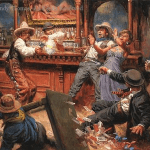
Bad Deal – 24″x 36″ – Oil
Andy didn’t begin his professional career in the fine arts. After graduating from high school, he went to work for Leggett & Platt, Inc. in their Marketing Service Department, an in-house ad agency. During this time he also attended Missouri Southern State College, graduating magna cum laude with a degree in Marketing Management in 1981. Employed for 16 years with the Fortune 500 company, he advanced to become its staff Vice-President before finally resigning his position in 1991 in order to pursue painting full-time.
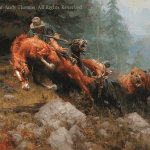
Grizzly Mountain – 30″x 40″ – Oil
I’ve always accused Andy of having a photographic memory because of his uncanny ability to record things he has seen or experienced. He denies my claim, but there is something extraordinary in his ability to capture a moment in time…to tell a story that is capable of transporting folks to another place and time. If he had lived in the old west, cowboys would have paid him to join them by the campfire and spin a yarn. His vivid memory and imagination enable him to create paintings pregnant with action and drama…paintings sought after by a growing number of collectors.
Desiring to learn more, Andy graciously agreed to an interview which I am pleased to share with you. I think you will find it interesting.
What would be your definition of art? I gave this a great deal of thought my first year as a full time artist. As I looked around and identified what I thought was art (including architecture, movies, comedians, choreography, etc), they all had two elements. The first was communication. That is, they all had to be received by the viewer or listener. The second was they were original in that there was no formula used. Sometimes I would find myself thinking “Gee, that’s great and I don’t know why”. So, I define art as creative communication. The real question for an artist is, “Who am I wanting to communicate with?”

Horse Thief – 24″x 36″ – Oil
You define yourself as a painter of history, how do you go about translating the written account into a fully realized painting? Painting an actual event is a challenge. If I am true to factual history, many of my creative tools are taken from me. Still, I can be somewhat creative and use my craft and research to produce a work that people appreciate. Historically based paintings that are not a specific event are much easier. I get much of my inspiration from reading personal journals and memoirs of the time because they are full of feeling and impressions.
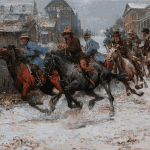
James Gang – 24″x 36″ – Oil
Your western themes have really caught on with collectors, why do you suppose that is? There’s a little boy inside me who wants to be a cowboy someday. I suppose that makes me paint westerns with enthusiasm.
How did you find your individuality as an artist? By painting many styles and subjects until my own style emerged.
Do you consider the process of painting more important than the result? No. The final painting is always my ultimate goal. However, I’m always amazed how indifferent I am about a painting that is finished. It is the past and I am looking forward to the next painting. Luckily, my buyers don’t feel the same.
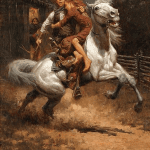
Johnny Saved the Girl – 40″x 30″ – Oil
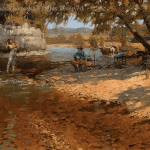
Journey to the New Home – 24″x 36″ – Oil
What part does photography play in your work? I use many photos for background reference but really only paint directly from photos for rifles or pistols and sometimes for hands. In the course of painting a figure, I often pose myself and take a photo to check anatomy or clothing wrinkles.
Does plein air painting play a part in your work? Plein air was one of the many types of painting I did to develop as an artist. I never learned to enjoy it and I only do them now for the fellowship of other artists.
What is the major thing you look for when selecting a subject? I have learned to fumble around with ideas until one gets me excited. Lots of thumbnails and color studies.
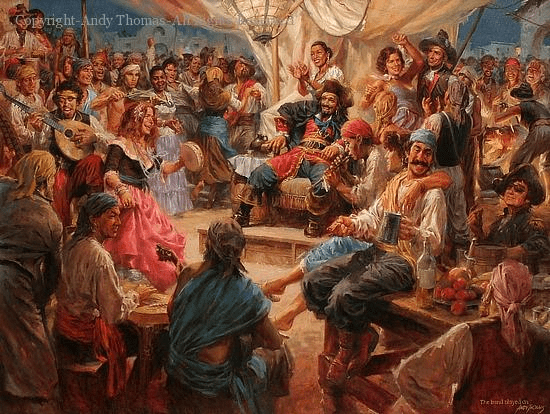
…And the Band Played On – 36″x 48″ – Oil
What is your major consideration when composing a painting? That’s tough to answer. I will say this; If my little thumbnail looks like a good composition, the color study will have a good composition as will the finished painting.
How thorough is your initial drawing? Very, very loose. I really let details emerge and develop as I paint. Sometimes I move arms or legs many times in the process.
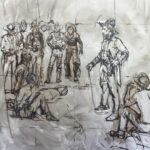
A piece currently on the easel shows the initial drawing with grid lines on a toned canvas.
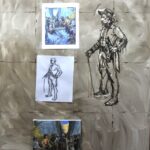
Current work on the easel shows the preliminary color study which has been reversed for the larger work. Also shown is photocopy of study and a preliminary figure study.
Describe your typical block-in technique. My usual procedure starts by taking a photograph of my color study and printing the image on an 8.5″x 11″ paper. I then draw a 16 square grid on the photograph. I prepare my large canvas by staining it with a brown/black mixture (ultramarine blue and transparent red earth). I use the same mixture to brush in a 16 square grid on the canvas and redraw the color study.
At this point, I usually block-in the whole canvas with thin color and soft edges. The washed in canvas should have the correct color, value and composition of the finished painting with no details. I then begin the slow process of finished, detailed painting by working on individual figures or small areas and working around the canvas.
How do you decide the dominating mood for a painting, and how do you maintain it? My paintings are narrative, storytelling affairs and the mood of the painting is part of the story. The mood is controlled by the choice of light source, the deepness of the shadow areas and the body language and expressions of the figures. Since I use figures often, body language is important. I never paint a man just standing. My men stand in defiance, or in fear, or with boredom, etc. That’s what I try to do, anyway.
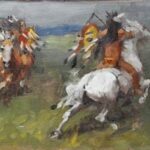
This is typical of small preliminary color studies Thomas does as preparation for the larger work.
What colors are most often found on your palette?Ultramarine blue, transparent red earth, Venetian red, cadmium yellow deep and zinc/titanium white are always on my palette. I keep cadmium yellow light and cadmium red available but rarely use them. My vision is color weak so this limited palette suits me.
What are the key points one needs to know when creating a true sense of atmosphere? Light source, light source, light source.
You have a strong affinity for illustrators of the past, why is that? I think they were the best artists. They did paintings that fascinate me. They have not had a chorus of art historians promoting them.
So, if you could spend the day with any three artists, past or present, who would they be? Howard Pyle, Charles Russell and Frederic Remington.
What advice would you have for a young artist/painter? Here’s the best advice that was ever given to me. I asked an artist I greatly admired the same question, hoping he would tell me something like “paint horses, you can make good money painting horses” or “go to this show and you’ll sell out”. Instead, his answer addressed my artwork; “Whatever you see as your weakness, attack it. For example, if you can’t paint hands, practice until you can”. I followed his advice. The same artist, when I asked him what was the most important thing about a painting, immediately said, “The reason you wanted to paint it in the first place”. Perfect answer. The artist was John Pototschnik.
What advice do you have for a first-time collector? My experience shows me that people who only buy artwork they personally like are forever happy with their choice. I was always uncomfortable when people looked at my work for decorative or investment reasons. I do know that a painting that you enjoy doesn’t require maintenance or your time like so many other things we buy.

Land of the Apache – 24″x 36″ – Oil
When you become discouraged and feel the well is dry, so to speak, what do you do? I look at other artwork. For instance, I spent a great afternoon the other day making a list of my favorite all-time paintings and printing slick copies of them off the internet. I never really finished the list and before I was done I had ordered two more art books. But I had fun and was ready to paint.
Finally, Andy, if you were stranded on an island, which three books would you want with you? Atlas Shrugged (because of the message and because it would take being marooned to get me the time to reread it), and True Grit (better with each rereading). My third book would be some sort of survival guide so I wouldn’t be hungry while reading the other two.
Thanks Andy for a wonderful interview.





















